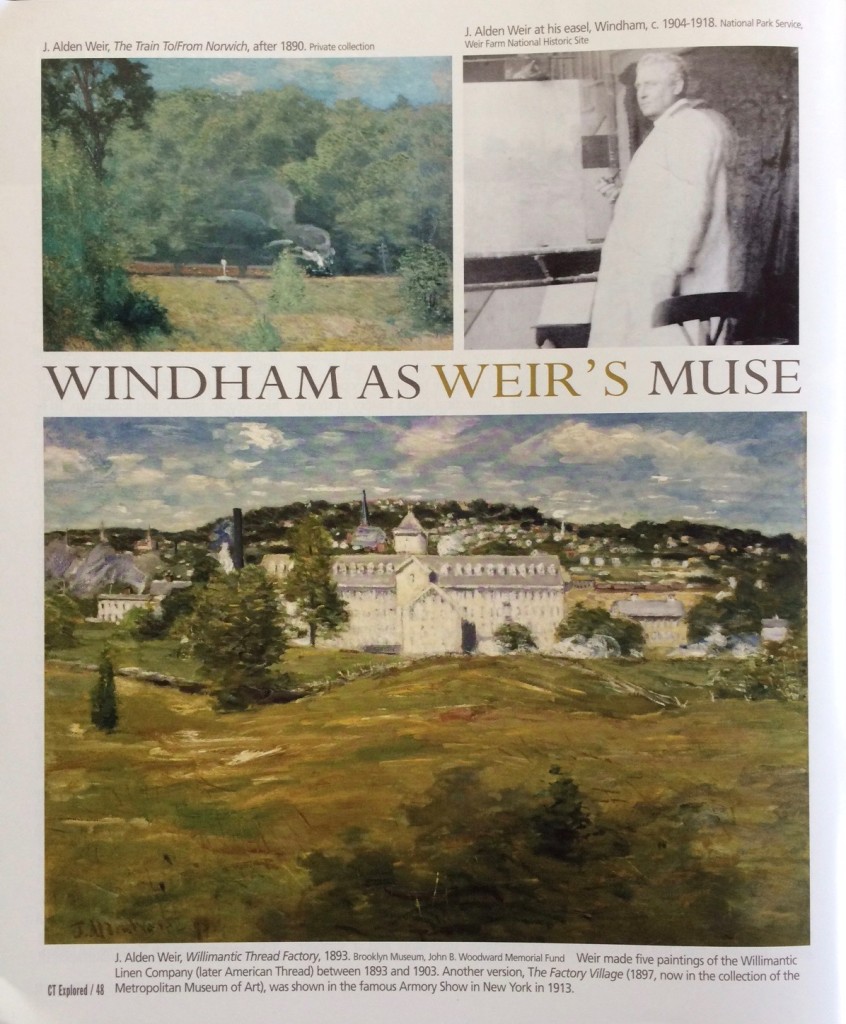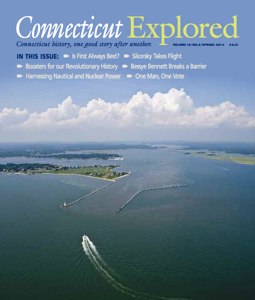 By Anne Dawson (c) Connecticut Explored. Spring 2014
By Anne Dawson (c) Connecticut Explored. Spring 2014
J. Alden Weir, one of America’s most accomplished impressionist artists, is memorialized at Connecticut’s only national historic site, Weir Farm in Ridgefield. But he was also inspired by the summers he spent in Windham, Connecticut during the early 1880s until his death in 1919. Weir, who served as both president of the Society of American Painters (elected in 1882) and president of the National Academy of Design (elected in 1915), was a founding member of The Ten American Painters, a group of radical artists formed in 1897 that worked to reposition American painting away from its conservative tendencies toward the more modernist style of impressionism.
Weir was born in 1852 in West Point, New York. His famous Connecticut connection is with his farm in Branchville (part of Ridgefield, in Fairfield County), which is beautifully preserved as the only national historic park in Connecticut. Branchville’s fame, however, obscures Weir’s passionate involvement with Windham Center in eastern Connecticut’s “Quiet Corner,” where Weir created some of his finest works. The Red Bridge, originally titled Iron Bridge at Windham, is renowned for its modern synthesis of nature and industry. It features beautiful impressionist brushstrokes, a brilliant color palette, and a sophisticated abstract compositional structure inspired by Japanese prints. Weir’s Connecticut Village (1891) portrays a view of Windham Center homes as seen from the northeast corner of his Windham property. Weir’s Windham home, which today is privately owned, looks much the same today as it did in Weir’s time.
Weir’s tie to Windham Center began when he met Anna Dwight Baker, in January 1882, according to Dorothy Weir Young in The Life and Letters of J. Alden Weir (Yale University Press, 1960). The young Anna was a drawing student at Weir’s studio in New York City’s Washington Square. Anna’s family typically spent the winters in New York City and summers at the Baker family home in Windham Center. Three weeks after they met, Baker and Weir were engaged. In May, Weir visited her in Windham; afterward he wrote, “No hour in the day passes but what I recall the first Connecticut hours we had in the charming little village of Windham. This is really the first Connecticut village that I have really ever known & now I feel that a chain is connected to all villages.”
Those first days in Windham set the stage for Weir’s 37-year relationship with this picturesque slice of eastern Connecticut. Weir painted some of his most famous pictures there, including The Red Bridge (1895) and The Factory Village (1897), both now in the collection of the Metropolitan Museum of Art, and Willimantic Thread Factory (1893, Brooklyn Museum of Art). The Factory Village was shown, among other works by Weir, at the groundbreaking New York Armory Show in 1913. Hollis Clayson describes The Red Bridge in The Weir Family, 1829-1920, Expanding the Traditions of American Art (University Press of New England, 2011), as one of the “indisputable masterpieces of U. S. modernism.”
Although Weir bought the farm in Branchville shortly after meeting Anna, for the rest of his life he visited both Connecticut locations at least annually, generally spending June and July in Branchville and August and September in Windham. When Anna died after childbirth in February 1892, her sister Ella cared for the Weirs’ three children. Weir married Ella in October 1893. When Ella’s mother, Anna Bartlett Dwight Baker, passed away in 1899, she inherited the Windham Center farm and other financial resources, allowing Weir to retire from teaching and paint full time.
After 1899 Weir spent up to six months a year in rural Connecticut. He shared his love of the area and comforts of his home with several close friends who were also prominent American painters. Albert Pinkham Ryder visited in September 1903, and John Singer Sargent visited in early November 1919, just one month  before Weir passed away. Neither artist appears to have painted during these visits. Childe Hassam, on the other hand, painted at least two works while staying with Weir in August 1905. Emil Carlsen came more frequently and stayed for the longest stretches of time; his visits inspired two of his most stunning landscapes, Night, Old Windham (1904), now in the collection of the Florence Griswold Museum, and Weir’s Place at Windham (1905).
before Weir passed away. Neither artist appears to have painted during these visits. Childe Hassam, on the other hand, painted at least two works while staying with Weir in August 1905. Emil Carlsen came more frequently and stayed for the longest stretches of time; his visits inspired two of his most stunning landscapes, Night, Old Windham (1904), now in the collection of the Florence Griswold Museum, and Weir’s Place at Windham (1905).
Weir spent the last summer and fall of his life in Windham, then, following his lifelong routine, traveled back to New York City for the winter. He died there on December 8, 1919. After a service in New York, Weir was laid to rest in the Baker family plot at Windham Center alongside his beloved first wife Anna and their infant son. Later, his second wife and two of his daughters were also buried there.
Anne Dawson is professor of art history at Eastern Connecticut State University. When this appeared she was working on a multi-author book and an exhibition about Weir’s life and work in Windham, scheduled to open at the Lyman Allyn Museum in 2016.
Explore!
A Good Summer’s Work: J. Alden Weir, Connecticut Impressionist
On view May 7- September 11, 2016
Lyman Allyn Art Museum, 625 Williams Street, New London
For more information see http://harrisonjudd.com/weir_in_windham
Weir Farm National Historic Site, 735 Nod Hill Road, Wilton. nps.gov/wefa
